The 2019 LCGC Awards
LCGC North America
The contributions of Milos V. Novotny and Ken Broeckhoven, the winners of the 2019 LCGC Lifetime Achievement and Emerging Leader in Chromatography Awards, are presented.
This feature article discusses the contributions of the winners of the 2019 LCGC Lifetime Achievement and Emerging Leader in Chromatography Awards.
Milos V. Novotny and Ken Broeckhoven are the winners of the 12th annual LCGC Lifetime Achievement and Emerging Leader in Chromatography Awards, respectively. The LCGC Awards honor the work of leading separation scientists for lifetime achievement and emerging potential (Table I). For the fifth year, the award winners will be honored at an oral symposium as part of the Pittcon 2019 conference, held this year in Philadelphia on March 19. The presentations will feature talks by each award winner, as well as by Gert Desmet, Robert T. Kennedy, and Milton L. Lee. The Awards Session will be held on Tuesday, March 19, from 1:30 pm to 4:55 pm.
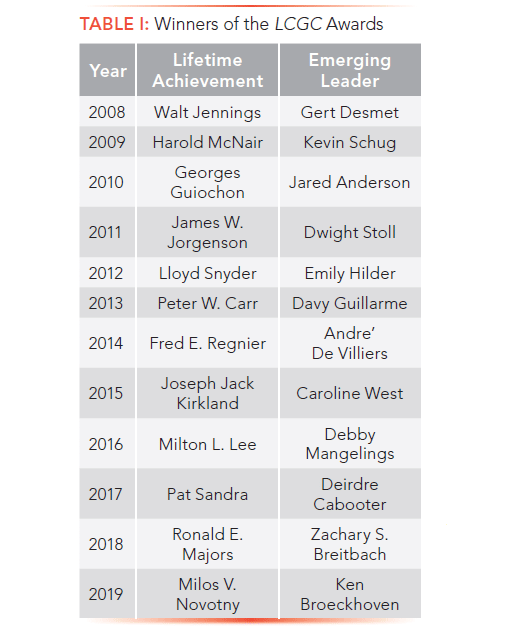
Table I: Winners of the LCGC Awards
The Lifetime Achievement Award
The Lifetime Achievement in Chromatography Award honors an outstanding and seasoned professional for a lifetime of contributions to the advancement of chromatographic techniques and applications.
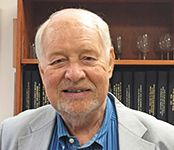
Figure 1: Milos Novotny.
Milos V. Novotny, the 2019 winner, received his undergraduate and graduate degrees in biochemistry from the University of Brno (now Masaryk University), in what is now the Czech Republic. In 1968, he emigrated to Sweden, and held a position of Research Assistant Professor at the Royal Karolinska Institute in Stockholm in mass spectrometry. He then moved to the United States as a postdoctoral fellow at the University of Houston, in Texas. In 1971, he was appointed an assistant professor of chemistry at Indiana University; he was promoted to associate professor in 1974, and full professor in 1978. In 1988, he was named the James H. Rudy Professor of Chemistry, in 1999 a Distinguished Professor, and in 2000 became additionally the Lilly Chemistry Alumni Chair. He was also the Director of the National Center for Glycomics and Glycoproteomics there from 2004 to 2009. He is currently the Director of the Institute for Pheromone Research and the Director of the Novotny Glycoscience Laboratory.
Novotny's contributions to the field of chromatography span a wide range of activities. He was a pioneer in virtually all capillary separation techniques, starting with significant surface treatment technologies in the preparation of glass capillary columns for gas chromatography (GC). He developed the first credible combination of capillary GC with mass spectrometry (MS) in the late 1960s, and continued with his conceptually important work in capillary liquid chromatography (LC) and supercritical fluid chromatography (SFC) in the late 1970s. This was followed by seminal contributions to capillary electrophoresis (CE) and capillary electrochromatography (CEC) of peptides and carbohydrates about 10 years later. He is known as a major contributor to important methodologies, based on LC–MS and CE, in the areas of glycomics and glycoproteomics. He also made a unique contribution to separation science and society at large by designing two chromatographic columns that were an important component of miniaturized GC–MS equipment that was landed on the surface of Mars in July 1976 by the U.S. National Aeronautics and Space Administration (NASA) in the Viking Mission.
Novotny received an Honoris causa doctorate from Uppsala University (Sweden) in 1991, a Doctor of Science degree from his alma mater Masaryk University in 1992, and an honorary doctorate from Charles University, in Prague, in 2007. Novotny was named a foreign member of two scientific academies: the Royal Society for Sciences, Sweden (1999) and the Learned Society/Academy of Czech Republic (2005). He has received more than 25 national and international awards for his work.
A Love Affair with Chromatography
Novotny says that his "love affair" with chromatography started during his undergraduate research in 1961. "While the methodology I was using (mostly paper chromatography) was clearly primitive by today's standards, I could somehow relate to the impact that A.J.P. Martin and his colleagues made in separating and detecting the mixtures of amino acids at the microscale," he said. But it wasn't love at first sight. He was trying to separate components of an alkaloid mixture and the paper chromatography was slow, and the solvent systems were inefficient. His frustrations quickly ended, however, when he heard about a new technique, thin-layer chromatography (TLC). "TLC was, to me, chemistry at its best: I was able to play with different adsorbents, quickly optimize the solvent systems, and even come up with my own ways to visualize and detect the separated TLC spots," he says. "I became thus a sort of local TLC expert as a second-year university student who was ready to solve everyone's problems through chromatography." After choosing biochemistry for his graduate studies, Novotny used more-established chromatography techniques to purify proteins and began appreciating the real structural complexity of biological systems, a perspective that he feels served him well throughout his research career. "I was even then an analytical chemist by heart, but my biochemistry background was important as a long-term incentive to develop better ways to separate and identify important biological compounds," he says.

Figure 2: Milos Novotny receiving the M.S Tswett Chromatography Medal at the Advances in Chromatography Symposium in 1984 (Photo courtesy of Milton Lee).
It was at this point that Novotny's "American journey in chromatography" began. After completing graduate school, he went to the Karolinska Institute in Stockholm to work as a research assistant professor in mass spectrometry. But the political situation in Czechoslovakia was worsening, and he had to decide where to live permanently. "I thought an English-speaking country would be professionally preferable at the time," he says. "Why not America?" This took him from a cool summer in Sweden to the sweltering heat of Houston in August of 1969, for a two-year post-doctoral position with Albert Zlatkis, a move he describes as an extremely important transition in his entire career.

Figure 3: Novotny in 1977 in Amsterdam, The Netherlands, on the occasion of the 12th International Symposium on Advances in Chromatography organized by Al Zlatkis. Left to right: Leslie Ettre, Al Zlatkis, Joseph Huber, and Milos Novotny (Photo courtesy of Pat Sandra).
"I owe much gratitude to Al Zlatkis for many things, but perhaps most for his insistence that I apply for an academic job," says Novotny. He had thought he wanted a job with an instrument company, but at Zlatkis' insistence, applied to five academic institutions and received invitations to visit three. "The interviews opened my eyes to academia," Novotny says. "I never regretted my decision to accept." Thus began Novotny's career at Indiana University, where he developed a highly respected research program and mentored future leaders of the field.
Groundbreaking Work Across Capillary Techniques
Novotny's groundbreaking work began with GC in his early research in surface wettability problems in preparing highly efficient glass GC capillaries (1,2). The surface treatment techniques enabled high-performance separations for biological mixtures, which was revolutionary. This work also led to pioneering research in the early demonstration of capillary GC–MS and its applications to complex mixtures. Novotny applied glass capillary columns to the separation of complex steroid mixtures, which became one of the milestones in the development of chromatography (3,4). This work became internationally known very quickly and stimulated a great deal of interest in high-resolution separations.
Novotny's group at Indiana was one of the first to apply serious chemometrics to chromatographic problems (5,6). This work was spearheaded by graduate students Mike McConnell and Jerry Rhodes, who applied non-parametric pattern recognition in the analysis of urinary volatile profiles from diabetic patients. "The metabolic patterns at 95% correct classification were subjected to a feature-extraction algorithm for selection of metabolically significant components for the subsequent GC–MS identification," Novotny explained. "While these procedures may seem trivial through the eyes of today's computational technologies in the "omics era," ours were developed during the 1970s!"
Novotny then moved into new areas: capillary LC and SFC. In 1978, two key papers were published (7,8), which are considered by many to be the beginning of the field of capillary LC. The intellectual foundation for this idea was inspired by the theoretical insights of J. Calvin Giddings of the University of Utah. "As a young scientist in Czechoslovakia, I had almost religiously studied his classy 1965 book Dynamics of Chromatography and related papers," he says. "There it was: To counter the much slower solute diffusion in the liquids, you have to resort to very small, preferably spherical, particles, with small diameter columns, which eventually necessitate the use of unusually high column inlet pressures."
The development of capillary SFC is quite a different story, Novotny says, but also has connections to the observations made by Giddings and coworkers in the 1960s, in this case on the solvating properties of dense gasses near the critical point. "My former graduate student, and later a faculty member at Brigham Young University, Milton Lee, spent two highly productive summers at Indiana, and I introduced him to my thoughts on 'rejuvenating' Giddings' dense-gas ideas in terms of much improved capillary column technologies," Novotny recalls. "Milton and my students collaborated and it worked; the rest is history." Capillary SFC enriched both his and Lee's research programs, attracted other groups into the field, and was successfully commercialized, Novotny says, while noting that further developments in SFC later took "some unexpected turns."
A Broad Impact
What are Novotny's biggest contributions to chromatography? We asked leading researchers for their perspectives.
Milton Lee, the Emeritus H. Tracy Hall Professor of Chemistry at Brigham Young University, emphasized the broad nature of Novotny's work. "Milos has unique insight into the whole field of separation science. He has had first-hand experience in all forms of chromatography and electrically driven separations, and their coupling with mass spectrometry," he said. "I always come away with new ideas, understanding and enthusiasm from discussions with him, as I am certain is the case for others."
Jim Jorgenson, the Kenan Professor of Chemistry at the University of North Carolina at Chapel Hill, also cites Novtony's prolific contributions: "His extremely early work in capillary GC and capillary GC–MS. His pioneering work in profiling metabolites (1970s) that is the forerunner of metabolomics. His extremely early work (around 1978) in capillary LC. His 30 years of devotion to developing analytical methodologies for complex carbohydrates. His 45 years of highly successful studies of mammalian pheromones." This is a short list of Novotny's accomplishments.
Bob Kennedy, a chemistry professor at the University of Michigan, also cites Novotny's diverse contributions, including his development of capillary gas chromatography columns, capillary liquid chromatography columns, and methods for glycobiology. "I think that the capillary LC is especially interesting because many people didn't believe that it would ever have an impact in analytical chemistry, but now techniques based on work he did are routinely used," Kennedy says. "His early work in this area made possible my PhD work on single cell analysis." Kennedy appreciates Novotny's work in glycobiology because it addresses such a hard problem; the structures are complex and analysis and interpretation are challenging. "By just working on it, [Milos] inspired many others to get involved and help move the field forward," Kennedy says. "Now we know how important these glycosylations and related modifications are."
Pat Sandra, an Emeritus Professor at Ghent University in Belgium and the Director of the Research Institute for Chromatography (RIC), also praised Novotny's fundamental contributions to the present-state-of-the-art of all pressure- and electro-driven separation techniques: capillary GC, microcolumn LC, SFC, CE, CEC. He also applied these techniques to study small molecules (identifying the first mammalian pheromones, and glycans) and large molecules (proteomics). "Needless to say, he also developed unique sample preparation methods for biological samples," Sandra adds. "Very few colleagues were covering such a broad research field, giving him a helicopter view over separation methods and their applicability."
Susan V. Olesik, a professor and chair at Ohio State University, has known Novotny since she was a postdoctoral researcher in his laboratory in 1982. They collaborated on the first Fourier-transform–infrared (FT-IR) interface for SFC. Olesik feels that Novotny's most significant contributions to the field include capillary GC systems to collect and describe pheromone analysis long before others even considered such work. "He and Milton Lee started the entire field of analytical separation science," she says. "He led analytical separation science into microscale packed capillary column LC with very efficient and relevant separations." Later in his career, Olesik says, "[Novotny] revolutionized the study of glycopeptides based on high-efficiency separations combined with mass spectrometry."
A Unique "School of Chromatography"
Even given the groundbreaking nature of so many of Novotny's advances in capillary techniques, many cited his work as an educator among his greatest accomplishments. For example, Milton Lee says that even though Novotny is recognized as one of the earliest pioneers in both capillary GC and LC, and especially their application to biochemical problems, his greatest contribution may be his influence on countless separation scientists worldwide through training students, postdocs, and visiting scientists. "Milos is passionate about the field of separation science and is uniquely gifted in his ability to motivate and inspire others, especially young people and those new to the field," he said. "He will always be an active voice in promoting excellence."

Figure 4: Milos Novotny (right) and Pat Sandra at the Golay award ceremony in 1998 at the 20th International Symposium on Capillary Chromatography (ISCC) meeting in Riva del Garda, Italy. The 1998 award was presented to Hans Poppe (University of Amsterdam, The Netherlands) and Milton Lee (Brigham Young University, Utah, USA), a former student of Novtony's (Photo courtesy of Prof. Pat Sandra).
Kennedy agreed, pointing out that Novotny mentored so many students who became exceptional analytical chemists. "Certainly, the quality of his research instruction has contributed to the outstanding accomplishments of his many former students and post-doctoral associates including Jim Jorgenson, Milton Lee, Victoria McGuffin, Takao Tsuda,, and Susan Olesik," He said. "This is a remarkable group of people, all of whom received their education from Milos."
"Milos created a unique 'chromatographic school'!" said Sandra. "For example, several of his students are recipients of the ACS Chromatography award, such as Milton Lee, Jim Jorgenson, and Susan Olesik."
As one of Milos' first graduate students, Milton Lee had first-hand experience of Novotny's mentorship. Lee started his graduate studies in 1971, the same year Novotny arrived at Indiana University. "As a graduate student, I interacted with Milos almost every day that he was at the university," Lee recounts. "He was keenly interested in our daily progress and visited the laboratory often, sometimes several times a day; we didn't need to make appointments – there was plenty of opportunity to talk with him rather informally." And Novotny's influence on Lee and on his career did not end with his degree at Indiana University, but has continued ever since. "He is still my greatest professional colleague and advocate, and I know that this is also the case for his other students," Lee says. "He is extremely proud of all of our accomplishments." Over the years, he and Milos became the best of friends.
Jim Jorgenson also has fond memories of his graduate school experience with Novotny. In particular, Jorgenson appreciated the encouragement to be independent and curious. "He did not try to force me to just be focused on my thesis project (pheromones) but supported and encouraged me to pursue a whole range of ideas in separations," Jorgenson recalls. "It was these additional projects that became the core of my entire career as an independent researcher. Had Milos not provided that freedom and encouragement my life would likely not have turned out as exciting and fulfilling for me."
That encouragement has extended beyond Novotny's immediate graduate students. As an academic "grandchild"-having earned his PhD from Jim Jorgenson, one of Novotny's students-Kennedy felt that Novotny always took extra interest in him and his career. "For example, I can remember often seeing him in the audience when I gave a talk," Kennedy says.
"He has always made a point afterwards to talk to me about it and provide insights."
Kennedy adds that Novotny has been one of his most important mentors after his PhD and post-doctoral research advisors. "He has great insight into working at the interface of biology and chemistry, and I would consider him one of the founders of bioanalytical chemistry," he says. "I learned from him, for example, that working on biological problems is a great way to be inspired for new analytical challenges." Kennedy remembers seeing early talks of Novotny's on diabetes complications where he used methods he developed to study the effects. "I knew that was what I wanted to do when I saw it," recalls Kennedy.
Novotny's personal impact went far beyond his students, affecting other researchers and collaborators. Pat Sandra relates his first encounter with Novotny's work. "Through literature study, I came across the work of Milos Novotny and was immediately very impressed by his work," he said. "For example, in 1969, he described not only the preparation and characterization of open tubular columns but also their hyphenation to mass spectrometry. This was definitely the approach I should apply to unravel the contribution of hops to beer [my very Belgian research]."
Sandra and Novotny first met almost a decade later, in 1977, and ultimately ended up collaborating. "We worked scientifically together in some projects related with the determination of chemical signal profiles from biological media," Sandra says. "Milos was an authority in pheromone research." And with time, the collaboration turned into friendship. "Over the years, we became very close friends sharing not only science but also topics such as culture, art, and European history," Sandra says. "Milos indeed has a very broad knowledge and interest and our conversations and discussions, often with a glass of red wine, were very lively and stimulating."
So as researcher, mentor, teacher, colleague, and friend, Milos Novotny has given much to the field of separation science. Olesik succinctly sums up his impact. "He has such a wealth of knowledge both in the analytical separation and biochemistry that the number of fields that he might impact [now and in the future] are too numerous to list."
The Emerging Leader Award
The Emerging Leader in Chromatography Award recognizes the achievements and aspirations of a talented young separation scientist who has made strides early in his or her career toward the advancement of chromatographic techniques and applications.
Ken Broeckhoven, the 2019 winner, received his PhD in 2010 from the Vrije Universiteit Brussel (VUB), in Belgium. Following post-doctoral research at VUB and work as a visiting researcher in the separation processes laboratory at the Swiss Federal Institute of Technology (ETH Zurich), in Switzerland, he became a research professor at VUB in 2012. He was subsequently promoted to assistant professor and then to his current position as an associate professor in 2017.
Important areas of Broeckhoven's work include theoretical and experimental studies applying the kinetic plot method to gradient chromatography, laying the basis for the application of the method to other liquid chromatography (LC) modalities and toward its use in supercritical fluid chromatography (SFC) and gas chromatography (GC). He developed a novel solution for the effects of viscous heating in ultrahigh-pressure liquid chromatography (UHPLC); and the first demonstration of the use of very high operating pressure (up to 2600 bar) in typical column dimensions (2.1 mm inner diameter [i.d.] columns) used in UHPLC instrumentation, and later extended this approach to gradient chromatography. He has also shed light on the future direction and limits of separations power in liquid chromatography, including the importance of extracolumn band broadening as one of the limiting factors for further improvements in separation speed and efficiency. Broeckhoven's work revealed the significant effect that turbulent flow in the connection tubing can have on the operating pressure and separation results in supercritical chromatography.
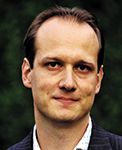
Figure 5: Ken Broeckhoven.
Broeckhoven has published 61 papers, with more than 850 citations. He has also given more than 40 oral and 52 poster presentations at scientific conferences, one of which received first place in the poster award competition at HPLC 2008 conference in Boston.
One of Broeckhoven's most cited papers (80 citations) involves a description of the kinetic plot method. This method was originally developed for isocratic separations and was extended for use in gradient elution separations (9). For any data set containing the separation efficiency and the flow rate from a single column, the data may be converted into a kinetic performance limit curve of the tested separation medium. This paper presents experimental and numerical data corroborating the conclusion that the kinetic performance limit curves are independent of the column length for the collected data.
In another highly cited paper (10), Broeckhoven and colleagues described their work to double the operating pressure for UHPLC. In addition, the paper describes kinetic gain factor expressions, while constructing the corrected Knox and Saleem limits. The work even considers the effect of extracolumn band broadening. The paper reported, "The equations show that the possible gain by moving from 1200-bar to 2400-bar instruments would at most lead to a 40% increase in efficiency and only 20% in resolution or peak capacity, while analysis time would halve." This method demonstrates a requirement for radical design changes for optimized chromatographic systems.
Advancing the Fundamentals of HPLC and UHPLC
Broeckhoven's most cited papers to date (11–13) discuss advances related to questions of optimization and efficiency in designing and applying peak capacity in HPLC. This work represents novel, in-depth research into existing technology. He began his interest in this technology through initial studies as a chemical engineer in the field of LC. He began working with Pat Sandra and Frederic Lynen at Ghent University, where he began collaborating with Deirdre Cabooter. His first investigation was an inquiry into why very narrow bore (1 mm i.d.) columns, ideally suited for UHPLC, showed poor performance compared to 2.1- and 4.6-mm i.d. columns. "Unfortunately, the project failed due to the much too large system dispersion common for earlier generation LC systems, but I got a lot of hands-on experience in LC which landed me in the follow-up project on kinetic plots originally developed by my promotor Gert Desmet," Broeckhoven says. "By developing a framework from gradient LC, we also paved the way the extend the kinetic plot methodology to other chromatographic techniques."
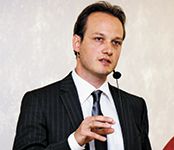
Figure 6: Ken Broeckhoven speaking at the 9th Balaton Symposium on High-Performance Separation Methods, in Hungary, in 2013 (Photo courtesy of Ken Broeckhoven).
Broeckhoven's research has moved from whole system measurements to elucidating the different contributions of individual components such as the injector, the detector, and tubing. These new discoveries are yielding information for new design work for the development of the next generation of LC instruments. For example, Ken points out that recently Prof. Attila Felinger of the University of Pécs, in Hungary, showed that the column hardware (frits and inlet) has a significant effect on column efficiency. This is an area of research that had received little attention previously.
One of Broeckhoven's papers describes the advances in UHPLC technology and system design over the past three years (12). "Just a few years ago," he says, "many UHPLC systems were simply upgraded HPLC systems that were capable of operating at high pressures." Today that has changed; manufacturers have redesigned and optimized UHPLC systems for ultrahigh operating pressures and minimized system dispersion. "As a result, not only the pumps, but other parts, are fully optimized, including the injectors (for example, having the needle seat integrated on the injection valve), column ovens (different thermal modes, active preheating) and detectors (frequency and response time)," he notes.
In his most recent publications (14,15), Broeckhoven addresses band broadening of contemporary injectors in UHPLC. In this work his team was able to show that peak dispersion (variance) from the injection is not simply related to the square of the injection volume as commonly assumed. "Reducing the injection volume still reduces the peak widths, but not as much as one expects," he says. Although the team had some theories to explain this, it was not until they decided to go back to computational fluid dynamics simulations of the injection processes that they fully understood what was going on (15). "My colleague Sander Deridder, using a simplified model of injector geometry, showed that flow and diffusion occurring during sample load and injection inherently put a limit on how much you can reduce injection dispersion and that we would need to develop novel ways of introducing our sample if we want further improvements in injection band broadening," he says.
Broeckhoven feels that his main (and perhaps most useful) research contribution for the broader field of LC is in the methodology of how to extend the kinetic plot method to gradient LC. This work has enabled gradient LC to be used for optimization of real-life applications. "This theoretical basis from the gradient kinetic plot also serves to extend it to other techniques such as SFC, GC, and so on," he explains. In his future work, he plans to investigate a wide range of topics. "I want to look at topics ranging from the optimization of individual separation techniques (higher performance, faster separations, lower system dispersion), to the coupling of these techniques (hyphenation of LC, SFC, GC, and MS) and the necessary software to find the optimal separation conditions in a more automated way," he said.
The Contributions of a Young Researcher in Chromatography
Researchers and collaborators share the view that Broeckhoven is truly an emerging leader in chromatography. "Ken is a worthy winner of the emerging leader in chromatography award," says David McCalley, a professor of Bioanalytical Science at the University of the West of England, in Bristol, UK. He notes that Broeckhoven already a has an impressive publication record, and a publication h index of 20, despite his young age. "This achievement is all the more remarkable because his first major publication was as recent as in 2007," McCalley says. "He has also in this time had to contend with the great pleasures (and distractions!) of a young family."
McCalley appreciates many specific aspects of the work Broeckhoven has done, including contributing greatly to the understanding of kinetics in LC. "He was part of the group under professor Gert Desmet (his doctoral supervisor) in Brussels that developed the kinetic plot method for the rationalization of column performance, both in isocratic and in gradient elution chromatography," he notes. "Using these techniques, he has (amongst other studies) compared the properties of totally and superficially porous particles and helped to explain the differences in their performance." McCalley also values Broeckhoven's work to investigate aspects of current HPLC instrumentation including the band broadening contribution produced by ultraviolet (UV) detectors of different design, his study of the effects of UHPLC systems in excess of 2600 bar, and his investigations of column particle sizes smaller than those used in current commercial ultrahigh pressure systems. "This work has enabled researchers to understand the limitations of current instrument design and performance," McCalley concludes.
Desmet, a full professor at Vrije Universiteit Brussels, was Broeckhoven's supervisor for his MSc and PhD studies. But he had already noticed Broeckhoven when he was an undergraduate. "He stood out as the smart kid, always asking the right questions during my course on reactor technology," he said. And when he did his master's research, his MSc thesis work was so good that the legendary Michel Martin was under the impression that it was a PhD thesis. This outstanding work was presented as an oral contribution at the 2007 HPLC conference in Ghent by Gerard Rozing.
David S. Bell, a director of research and development at Restek, and the editor of LCGC's "Column Watch" column, agrees. "Ken has contributed much to the fundamental understanding of the physical contributions to separation technologies," he says. "He brings an engineering perspective to a largely chemistry oriented group."
Caroline West, an associate professor at the University of Orleans, in France, particularly appreciates Broeckhoven's work in SFC. "I mostly know Ken's fundamental work in SFC, where he has contributed to improving the understanding of band broadening effects, taking account of the specificities of the compressible CO2-based mobile phase," she says. "Because the conditions there are trickier than in other forms of chromatography, with many contradictory effects, this is a very challenging question."
Davy Guillarme, a senior lecturer at the University of Geneva, and a jury member of Broeckhoven's PhD defense in 2010, has known Broeckhoven for more than ten years and collaborated with him within the of Desmet's group. "From my point of view, Ken's most important contributions are around the fundamental understanding of chromatography, in particular kinetic performance (the Van Deemter equation, kinetic plots, and so on), frictional heating, band broadening, and simulation and modelization of the chromatographic behavior," he says. Guillarme also notes that Broeckhoven has been recently involved in the development of a new UHPLC system capable of working at very high pressures and doing work in SFC studying the interactions of turbulent flow, temperature effects, and isopycnic plots, among other subjects.
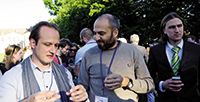
Figure 7: Broeckhoven at the HPLC 2015 Geneva conference dinner explaining a concept related to chromatography to Alberto Cavazinni of the University of Ferrara (Photo courtesy of Ken Broeckhoven).
Deirdre Cabooter, an associate professor at the University of Leuven, in Belgium, has known Broeckhoven since he began his master's thesis in Desmet's lab in Brussels in 2006. When discussing his most significant research, Cabooter also cites his work to advance fundamental understanding. "His work on mass transfer in liquid chromatography, the extension of the kinetic plot method to gradient separations, his work on extracolumn band broadening, and his work on UHPLC, at pressures of 2500 bar-these are his greatest contributions to date," she says.
Monika Dittmann, Principal Scientist at Agilent Technologies explains that Ken is an excellent scientist with the ability to work across experimental as well as theoretical aspects of chromatography. "His contributions to the field of mass transfer and kinetic performance of modern stationary phases as well as his studies of instrument related aspects have helped the entire community," she says.
The Future
Given Broeckhoven's accomplishments to date, his collaborators expect more good things from him in the future. Guillarme is convinced that Broeckhoven will continue to work in the field of fundamental chromatography, adding that this knowledge is essential for the practioners of chromatography. "Ken is already leading a sizeable research group at the University of Brussels, and his work has had strong impact on the community of separation scientists," he concludes. "I'm sure his research group will continue to grow."
Cabooter also sees great opportunity for her friend in his role in a tenured position at VUB. She believes he really likes the combination of teaching and research, in an environment where he is free to explore the fundamentals of chromatography. "Ken has already demonstrated that he can easily adapt to new concepts, for example by extending the kinetic plot method to supercritical fluid chromatography and gas chromatography," she says. "I foresee much more interesting and high-quality fundamental work from him in the future."
Desmet points out that Ken already has many important contributions to the field, with some of the highlights including the theory for gradient kinetic plots, intermediate cooling as a generic solution for viscous heating chromatography using 2.1 mm bore columns at 2600 bar and using SFC at 1200 bar.
"No doubt, Ken will become one of the leading experimental and theoretical specialists on the fundamentals of chromatography, working in close collaboration with industry wherever and whenever possible," concludes Desmet.
Bell believes Broeckhoven will continue to probe the limits of chromatography-exploring extremes of pressure, temperature, and flow. "If there is a breakthrough, I suspect he will jump to the next edge that interests him," Bell says.
References
(1) M. Novotny and K. TesaÅík, Chromatographia 1(7), 332–333 (1968).
(2) K. TesaÅík and M. Novotny, Chromatographia 2(9), 384–385 (1969).
(3) M. Novotny and A. Zlatkis, J. Chromatogr. Sci. 8(6), 346–350 (1970).
(4) M. Novotny and A. Zlatkis, Chromatogr. Rev. 14(1), 1–44 (1971).
(5) M. Novotny, M.L. McConnell, and M.L. Lee, J. Agric. Food Chem. 22(5), 765–770 (1974).
(6) M.L. McConnell, G. Rhodes, U. Watson, and M. Novotny, J. Chromatogr. B: Biomed. Sci. Appl. 162(4), 495–506 (1979).
(7) T. Tsuda and M. Novotny, Anal. Chem. 50(2), 271–275 (1978).
(8) T. Tsuda and M. Novotny, Anal. Chem. 50(4), 632–634 (1978).
(9) K. Broeckhoven, D. Cabooter, F. Lynen, P. Sandra, and G. Desmet, J. Chromatogr. A 1217(17), 2787–2795 (2010).
(10) K. Broeckhoven, and G. Desmet, TrAC, Trends Anal. Chem. 63, 65–75 (2014).
(11) D. Cabooter, F. Lestremau, A. De Villiers, K. Broeckhoven, F. Lynen, P. Sandra, and G. Desmet, J. Chromatogr. A 1216(18), 3895–3903 (2009).
(12) J. De Vos, K. Broeckhoven, and S. Eeltink, Anal. Chem. 88(1), 262–278 (2105).
(13) K. Broeckhoven, D. Cabooter, S. Eeltink, and G. Desmet, J. Chromatogr. A 1228, 20–30 (2012).
(14) K. Broeckhoven, K. Vanderlinden, D. Guillarme, and G. Desmet, J. Chromatogr. A, 1535, 44–54 (2018).
(15) S. Deridder, G. Desmet, and K. Broeckhoven, J. Chromatogr. A 1552, 29–42 (2018).
Jerome Workman, Jr. is Senior Technical Editor for LCGC North America and Spectroscopy. Direct correspondence about this article to Direct correspondence to jerome.workman@ubm.com

Measuring Vitamin K1 Concentrations in Dogs with Chronic Enteropathy Using LC–MS/MS
May 14th 2025A joint study between the University of Tennessee (Knoxville, Tennessee) and the University of Pennsylvania School of Veterinary Medicine (Philadelphia, Pennsylvania) compared directly measured vitamin K1 (vitK1) concentrations in healthy dogs and dogs with chronic enteropathy (CE) using liquid chromatography tandem mass spectrometry (LC–MS/MS); they also investigated whether supplementation of vitK1 in dogs with CE would significantly increase vitK1 concentrations.
HPLC 2025 Preview: Fundamentally Speaking (Part 2)
May 14th 2025Michael Lämmerhofer from the Institute of Pharmaceutical Sciences, University of Tübingen, Germany, spoke to JFK Huber Lecture Award winner of 2024 Torgny Fornstedt, professor in analytical chemistry and leader of the Fundamental Separation Science Group, Karlstad University, Sweden, about his pioneering work in high performance liquid chromatography (HPLC) with a focus on fundamentals, ion-pair chromatography, and oligonucleotide applications.

.png&w=3840&q=75)

.png&w=3840&q=75)



.png&w=3840&q=75)



.png&w=3840&q=75)









